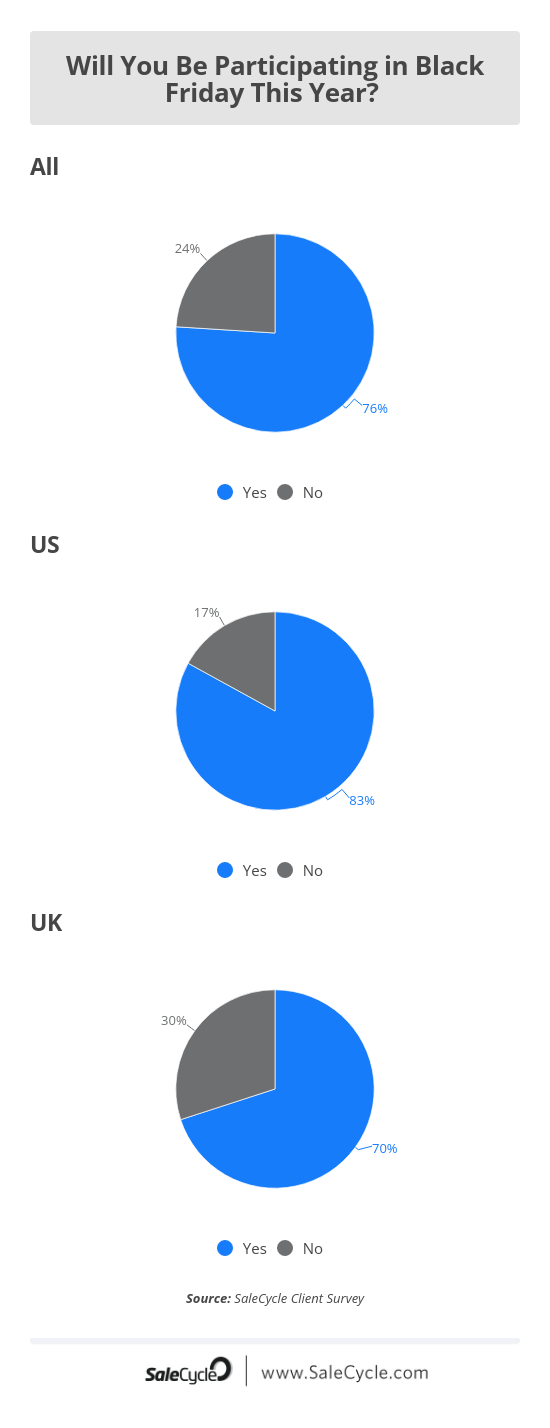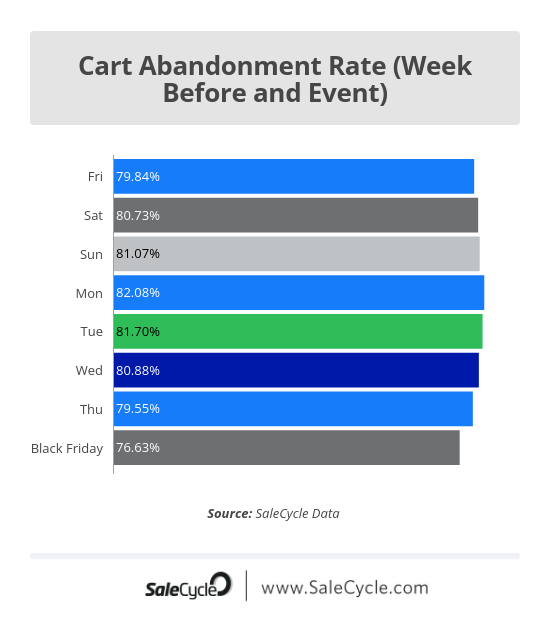Using opinions from a SaleCycle survey of US and UK retailers, we look at some of the benefits of Black Friday sales for retailers and we analyse the cons of participating in discounting around Black Friday weekend. Understanding the pros and cons can have a significant impact on retailer’s Black Friday ecommerce strategy.
The majority of retailers will be taking part in Black Friday promotions this year, according to our survey of retailers.


While we relay the information below we also dive into some of the Black Friday & Cyber Monday statistics.
Black Friday Benefits
Increased Traffic and Sales
People are looking for deals, they’re also shopping for Christmas, and Black Friday and Cyber Monday focuses a lot of traffic and sales into a short period. It’s the one of the best days for ecommerce sales throughout the whole year.
Last year, we saw sales volumes many times those of an average day on both Black Friday and Cyber Monday.
This is a clear opportunity for retailers to capitalise on customer demand and bring extra traffic to their sites.
An Opportunity to Clear Stock Before Christmas Season
Many retailers see Black Friday as an opportunity to clear old inventory in order to introduce newer stock in time for Christmas.
This applies to fashion retailers of course, but electronics retailers can also offer discounts on items like TVs and laptops knowing that newer models are coming soon.
Customer Acquisition
New customer acquisition can be expensive, but Black Friday offers retailers a chance to acquire new customers at a key time of year.
If you acquire customers around Black Friday, and keep them happy, then you have a chance to drive repeat sales in the Christmas period and beyond using a good post purchase email strategy.
If customers can be retained in the longer term and they buy at full price later, this justifies discounting around Black Friday.
Incremental Sales
People have a real intent to purchase around the Black Friday weekend and this can translate into incremental sales.
This means that customers head to sites looking for bargains, but end up buying full-price items as the money is burning a hole in their pockets.
Our own stats from last year show this propensity to buy. Normally, shopping cart abandonment rates for retailers are around 81%, but they’re much lower around Black Friday weekend.
Last year, abandonment rates dropped to 76.68% on Black Friday 2020 and 76.91% on Cyber Monday 2020 as people looked to grab a bargain.


Pro:Direct Sport Digital Marketing Manager David Tapp has seen this in action:
“Black Friday is a great day for driving users into the site for sale items, but it’s also a huge day for non-sale items too, with users coming to see if that item they wanted has been discounted, and then buying it even if it isn’t”
Easier Fulfilment
One benefit of shifting sales to earlier in the Christmas shopping season is that orders can be processed and shipped well before Christmas.
This means there’s no danger that people won’t receive gifts in time for Christmas, and also frees up capacity for later in the season.
Black Friday Negatives
Pressure to Discount
Black Friday has been known for generous discounts, and some customers have come to expect it.
This places pressure on retailers, as Simon Lancaster, Senior Optimisation and Analytics Manager at Tesco Mobile explains:
“Customers expect expect very heavy discounting. Which most mobile operators can’t do – particularly on Apple handsets where margins are smaller anyway.”
Impact on Margins
Our survey respondents were concerned about the impact on margins around Black Friday.
More sales are generated around Black Friday, and many retailers enjoy their busiest sales days of the year, but it can come at the cost of reduced profit margins.
Nike’s Gabriela Bergamasco explains the challenge for brands:
“As the consumer is already expecting offers, we can not avoid it (Black Friday). If we want a share of their spending, we must get attract customers’ attention with offers. However, we must be careful with our product margin to guarantee final results.”
Retailers need to consider how far they can realistically discount, as they can reduce margins on products they may have sold closer to Christmas at full price.
Then again, if they don’t discount, but their competitors do, retailers may be losing out to competitors.
It’s a conundrum for retailers.
It Can Generate Returns
Discounting and therefore selling more at this stage of the holiday season means that the cost of ecommerce returns to online retailers increase in the final weeks running up to Christmas.
That means that retailers’ distribution centres can become even busier at their busiest time of year.
There’s also a risk that goods returned may not be able to be sold before Christmas and may sit on the shelves until the next gift period comes along.
It’s Crowded and Competitive
With so many brands talking about their Black Friday discounts, it can be hard for a retailer to have their message heard above the noise.
Also, while Black Friday drives more search traffic, it also increases the competition for retailers.
Terms like ‘Black Friday deals’ are now targeted by publishers looking to push up traffic numbers, which makes it harder for retailers to achieve higher search positions for such terms.

Customers Have Been Trained to Wait for the Discount
With Black Friday / Cyber Monday now firmly established in customers’ minds, people are now expecting discounts.
This has a couple of effects. Firstly, sales are likely to drop in the weeks leading up to Black Friday, as customers prefer to wait for the possibility of a promo code or discount rather than buying items at full price.
Secondly, if shoppers expect mega discounts, it’s harder to persuade them to buy, even with a good discount.
With the nagging thought that better discounts might be out there, customers may be more likely to shop around before committing to a purchase.
This presents a challenge for retailers. They could look to price match as Curry’s does here (cleverly targeting customers who copy product titles) or stick to their guns and risk losing sales to competitors.

In Summary
Black Friday and Cyber Monday present many challenges for retailers, and they have to consider some of the cons of participating.
However, there are many positives to this retail event and, if managed well, retailers can look after their margins while managing to generate extra sales and acquire new customers.
Speak to an expert
Learn how to convert your online audience into revenue with our experts.
Graham Charlton
Graham Charlton is Editor in Chief at SaleCycle. He's been covering ecommerce and digital marketing for more than a decade, having previously written reports and articles for Econsultancy. ClickZ, Search Engine Watch and more.









![Valentine’s Day Ecommerce Tips and Trends [2024 Strategy]](https://www.salecycle.com/wp-content/uploads/2019/01/valentines-ecommerce-1.png)




![How SaleCycle helped Vodafone increase their online sales by an additional 2,000 additional sales per month [Extended Version]](https://www.salecycle.com/wp-content/uploads/2023/08/vodafone-banner.webp)




